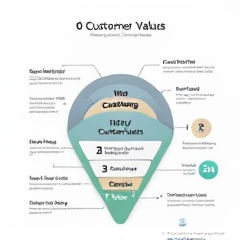Review of the book "Expert Business. Promotion, Money, Scale" - Artyom Senatorov
Artyom Senatorov's book "Expert Business" is a practical guide to monetizing knowledge and developing a personal brand. This review briefly covers the key ideas and benefits for experts.
This is not a place for mantras about "personal brand" just for the sake of it — every advice, painstakingly gained by the author from his own mistakes, is backed not by abstract reasoning, but by facts, as if from the accounting records of a successful startup.
- Senatorov takes the reader by the hand and leads them through the labyrinth of self-promotion.
- He never tires of repeating that being an expert is not a title, but a daily job.
- The work is measured not by likes, but by profit and scalable results.
- For example, he shows how one adjustment to the sales funnel brought him clients over six months.
The book conveys that the author is not one of those who feed the audience empty promises — all recommendations are hard-won in real business.
Every piece of advice sparks not only interest but also healthy skepticism: "Will this really work for me?"
It's precisely such details that turn the book from just another collection of tips into a desktop tool for those who really want to play big, rather than stalling in place waiting for a miracle.
Key Concepts and Their Analysis

In the depths of business literature, “Expert Business. Promotion, Money, Scale” by Artem Senatorov stands out not only for its passion for the topic but also for its evident practical vein: the reader is literally led by the hand along the bumpy road from the idea of an expert business to the first tangible profits.
The author does not limit himself to abstract theories — he examines with enviable meticulousness how to turn personal experience into a marketable asset, and is not shy about naming specific figures:
It is especially valuable that Senatorov does not tire of reminding: without a clearly built personal brand, counting on sustainable success is like trying to catch the wind with bare hands.
His advice on monetizing knowledge does not sound like banal slogans, but rather as a result of personal trials and errors — and it is precisely this that is most convincing.
- Concrete tools: Step-by-step algorithms and bitterly ironic remarks about typical failures, which many readers will find painfully familiar.
Who is the book for
You'll not find boring truisms for corporate giants or theoreticians lost in the clouds here: the target audience is the energetic practitioner, that very specialist who's tired of being stuck and finally yearns to convert their professionalism into a sustainable cash flow.
- Whether you're a consultant, a private tutor, or the owner of a mini design studio, there's something for everyone who dreams of becoming more than just "one of many" and becoming a figure in the market.
- The author seems to read minds: they break down how to build your name from scratch, where to find the first orders, and how not to give up after the fifth failure.
- The main thing is why the eternal wait for the "right moment" turns into years of stagnation in the starting workshop.
There's no room for rose-colored glasses on these pages: reality is here, with its disappointments, failures, and small victories, but this detailed route from point A ("I know something") to point B ("I'm paid so much that I stop counting pennies") is written specifically for those who are ready to act, make mistakes, and try again.
About the author and his significance in marketing

Senatorov is the person whose webinars attract a large number of listeners in the evening, and whose social media posts are regularly shared in professional chats:
- Among those who not only talk about promotion but also put it into practice, his name has long become a marker of “works - proven”.
- Behind him are not only dozens of implemented projects but also real experience of getting out of blind spots.
- His approach is not a set of templates, but a system forged on his own mistakes and trials.
- He knows how to change tactics in time: now, when most gurus are limited to theorizing.
- Senatorov is not afraid to share failures, discuss provocative issues, and offer unexpected solutions.
- It's this specificity, shining through every chapter, that turns the author into a figure worth following.
- Whose advice you really want to implement, even if you were sure before that “you've tried it all”.
The book's place in modern marketing literature
Against the backdrop of the dull sameness of "how-to guides for infobusiness", churned out like hotcakes at a train station, Senatorov's work stands out with its unflinching realism and wit: here you won't find clichéd quotes worn down to holes about "unique selling proposition" or vague advice in the spirit of "develop charisma".
This book has something that is chronically lacking in most modern marketing guides:
- A fresh perspective on the role of the expert's personality
- Ruthless analysis of numbers without tricks for the sake of a "wow effect"
- A sharp analysis of failures and successes with concrete conclusions
Amidst the abundance of life hacks and case studies that flood the market today, here we finally have a practitioner's voice that is not afraid to expose their own failures, so that the reader, who has often stumbled upon the same rake, finds in these pages not just a burst of inspiration, but a clear roadmap for their own actions.
That's why this book doesn't get lost among the loud new releases of 2025, but takes a confident place on the shelf alongside truly working tools for those who want not just to read about promotion, but to take themselves and their business to a new level — without fluff, without deception, with a focus on real results.
Relevance of the publication at the current moment

If you look back at the flurry of recent publications, where promises of easy earnings and instant success are made more often than bread is handed out at a supermarket tasting, it becomes clear: this is exactly when such a study hits the spot.
In an era of rapidly growing interest in individual consultations and online learning, attention to detail and honesty of analysis become a matter of survival, not just a decoration of the text.
- There is no usual candy wrapper here.
- The author does not cater to the naive belief in success with a click of the fingers.
- Consistently shows why it is impossible to do without building a strong personal image and competently packaging one's own experience today.
In conditions where millions of specialists are trying to find their audience on the internet, the book carefully examines how not to drown in digital flows and build a really working model of earning money from knowledge.
The significance of this approach is skyrocketing right now:
- Against the backdrop of inflation in trust in infobusiness.
- The reader gets no more illusions.
- Practical schemes, figures, statistics of failures and successes that can be applied to one's own reality tomorrow.
Fundamental Marketing Concepts

Instead of vague slogans about "secrets of success", here you will find a meticulous dissection of what is commonly referred to as the basic concepts of promotion:
- The author does not juggle vague categories, but rather breaks down the concept of "value for the client" literally layer by layer - from primary pain to expectations and real actions.
- The book does not shy away from simple, yet working things:
- The reader is encouraged to look beyond the familiar sales funnel and think about whether their product really solves a problem, rather than replacing it with another nice packaging.
- This fact is presented without embellishment, dryly and harshly.
- You can argue for hours about Maslow's theory of needs, but Senatorov ruthlessly brings the discussion down to earth:
- "Show what you can do, prove that it's needed by someone, and only then think about scaling."
- This approach is like an oxygen mask in a stuffy room - it forces you not to dream, but to count your strengths and weaknesses, and make conclusions not based on emotions, but on numbers and feedback from real clients.
Innovative ideas and modern trends
Instead of another portion of fashionable slogans about “breakthroughs” and “ultra-efficiency”, the reader is faced with a concrete analysis of innovative tools that are actually working in the market now:
- A detailed consideration of the personalized product line method, where the author demands not just segmenting the audience, but breaking it down into micro-needs;
- The question of new formats of communication — explosive sales growth through short videos;
- The trend towards hyper-personalization, necessary even for small projects;
- Every relevant innovation must be tested on real examples, not just on conference presentations.
Applicability of Concepts in Modern Business
Unlike most publications, where loud promises remain at the level of advertising banners, here each technology is broken down with such meticulous thoroughness that you can't help but test your own methods for strength:
- The author is not limited to theory, but generously shares step-by-step schemes for implementing micro-segmentation
- Shows how a simple breakdown of the target audience by unique "pain points" leads to salesli>
- Provides specific numbers and examples from the field of educational services and B2B
What impresses is not only the practicality of the recommendations, but also their ruthless truthfulness: the reader is not promised golden mountains in a week, but is warned that without an individual approach to each segment, one should not expect even an average result.
Here, you can feel the author's irritation with fashionable fluff — the emphasis is on verifiable, rather than beautiful, features.
What is especially striking is the analysis of modern content formats: it is not about mythical "coverage", but about specific changes in the behavior of users of short videos, for which now 30 seconds is already a victory.
Such a level of detail and passion for real cases makes the material not just relevant, but necessary for those who are tired of the eternal search for "secret tactics" and prefers to implement what really works.
| Key Idea | Essence |
|---|---|
| Step-by-Step Schemes | Clear instructions, not theory |
| Micro-Segmentation | Sales growth through precise targeting of the target audience |
| Real Examples | Cases from B2B and online education |
| Honest Approach | No promises of "golden mountains" |
| Criticism of Fashionable Techniques | Focus on working tools |
| Relevant Content Formats | Focus on short videos and target audience reaction |
Case studies and examples from real business
When the author takes the trouble to analyze others' mistakes and successes literally under a microscope, the skeptic inside wakes up, but quickly gives up: before your eyes flash living stories — for example, how a small team of online courses increased the number of applications from 80 to 98 in a quarter, simply by implementing segmentation by customer pain, and an IT agency broke out of the swamp of stagnation thanks to banal automation of primary contact and increased revenue.
There are no usual lyrical digressions here — data, screenshots, diagrams, conclusions, everything is in sight, without cuts or "magic": if someone failed, the author doesn't hide it, but dissects it into parts so that the reader doesn't repeat others' mistakes.
The impression is as if you're listening to an old acquaintance who is not afraid to call things by their names and give a slap on the back of the head for illusions. Against the background of the abundance of "water" in other books, such a pedantic attitude to the analysis of each step causes both respect and a desire to immediately check their processes — and, perhaps, for the first time in a long time, really change something, and not just put a tick in the list of read.
- Living stories of practical experience
- Increasing applications through segmentation
- Automation of primary contact
- Transparency of data and conclusions
- Pedantic analysis of mistakes
- Desire to change their processes
Strengths of the publication
The strongest thing that catches the eye is the uncompromising "transparency" of presentation: not a hint of obscurity and worn-out slogans, instead - specifics that can be grasped, and straightforwardness that you can't hide behind excuses.
The author doesn't just throw advice into the void, but literally lays out a blueprint on the table - with step-by-step examples, numbers, working tables, where it's clear:
- how the funnel was built,
- how much this or that campaign brought,
- how experiments with the product line ended.
The impression is that you're not getting a lecture, but access to the inner workings of business processes: the reader sees how specific people with their fears, mistakes, and joys move from point A to point B, and that this path is not strewn with roses, but is quite real.
Among the advantages is absolute practical benefit: here they don't just talk about the importance of personal branding or automation, but show how it changes the company's bottom line and the team's mood.
This approach not only motivates but also sobers - after just the first few pages, you're itching to implement something or, at the very least, stop deceiving yourself with pretty promises.
Critical Analysis
However, not everything is as smooth as it could be: in some places, the book suffers from excessive self-confidence and intrusive conviction in the universality of the proposed solutions.
The author, like a conductor, sets the tempo without always considering the diversity of genres — it's felt that under one comb are getting:
- startups
- companies with a ten-year history
In some chapters, there are recommendations that require a much larger starting budget than the average expert can afford; for example:
- launching advertising campaigns with a budget of 300 thousand and above is clearly not affordable for most beginners, about whom the author speaks so carefully on the first pages.
A reader with a keen interest searches for nuances but stumbles upon a recurring motif:
- “copy the best cases” without a deep analysis of the prerequisites for their success.
Few places reveal mistakes, failures, and alternative scenarios. As a result, despite the abundance of schemes and working tools, there is a feeling that:
- the book inspires decisive action more than it arms with universal recipes, and in some places even pushes to risk without insurance.
Tools and techniques for practical use
In the section dedicated to practical tools, Senator generously scatters a list of techniques throughout the pages, which, according to his plan, should become a guiding star for ambitious entrepreneurs:
- Checklists for creating a personal brand
- Auto-funnel templates
- Step-by-step schemes for building a product line
The author is not shy about specifics — for example, in one of the chapters, he promises to double revenue when implementing the "three-step offer system", and insists on monthly analysis of the sales funnel with a breakdown by channels down to the micro-ROI level.
However, in reality, these "universal master keys" often turn out to be too much for those who don't have a team of three marketers and a budget of at least half a million rubles behind them: elegant schemes risk remaining on paper if the reader is limited in resources.
Senator seems to forget that the path to the top is different for everyone: just the advice to "build an expert ecosystem" can stun someone who was afraid to even start a Telegram channel just yesterday.
Despite the abundance of tools and detailed instructions, sometimes there is a lack of real-life examples of failures, and most of the cases cited give the impression that the author chose them based on the assumption that "it only works for big and brave ones".
And if for an experienced market player these techniques can become a useful springboard, then for a novice — more likely, a reason for scepticism and caution.
| Technique | Benefit for a novice | Benefit for an experienced player |
|---|---|---|
| Checklists for personal brand | Difficult without experience | Useful |
| Auto-funnel templates | Can be confusing | Effective |
| Step-by-step schemes | Not always applicable | Applicable |
Popularity of the current publication

The book "Expert Business" by Artyom Senatorov quickly gained the attention of entrepreneurs, coaches, mentors, and experts seeking to build a personal brand and earn money from their knowledge.
The publication is actively discussed in professional communities, cited at business forums, and recommended in specialized online marketing courses.
The book's popularity is due to its practical nature: without unnecessary theory, it offers specific schemes for sales funnels, product packaging, and promoting expertise through social networks
Other works by the author
It is worth recalling that Senatorov already has a number of publications behind him, where, true to himself, he generously shares recipes for flawless entry into the “infobusiness elite” and constantly returns to the topic of personal branding:
- “Marketing on Steroids”
- “Personal Branding: Day by Day”
Familiar, painfully familiar clichés appear:
- “quick start”
- “monetization of expertise”
However, the freshness of the presentation invariably gives way to repetitive templates: even in the newest chapters, a recognizable appeal “do as I do — and it will work out” shines through.
Against this background, Senatorov's latest publications are perceived as a logical continuation of his own path of self-promotion, where each new publication is more of a showcase for his consulting business than an independent source of insights for a sophisticated reader.
Moving from book to book, the attentive reader will catch himself feeling déjà vu — as if the author deliberately shuffles the same advice under different sauces, once again calling for action, but rarely delving into the practical complexities faced by real businesses.
Comparison with other works by the author
In a comparative context, it becomes obvious: Artyom Senatorov again builds his narrative structure on familiar bricks — only slightly changing the facade and sign.
- The motivator's assertiveness: In his past publications, he pedaled "accelerated start" and "instant transformation of likes into rubles".
- Adding a twist: In the latest book, he tried to add fresh terms and trendy trends.
- Superficial novelty: The advice is presented in a new format, but its essence differs little from what was previously stated.
- Stuck in the paradigm of success: The author does not risk going beyond the familiar techniques, which are not always viable outside the sphere of online courses and mentoring.
- Déjà vu for the reader: Reading will more likely evoke a sense of déjà vu than genuine surprise.
| Aspect | Previous works | Latest book |
|---|---|---|
| Approach | Accelerated start | New terms |
| Essence | Viable advice | Superficial changes |
| Feeling | Novelty | Déjà vu |
Similar literature by other authors
Examining the shelf of modern business literature, one can't help but notice that many authors have already trampled the ground of "quick success", and each tries to pass off their old notes as something fresh - for example, Mikhail Dashkiev with his eternal "Business Youth: Instructions for Use" or Gandapas, who has been practicing games with personal recognition for years, offering readers another set of tips on self-presentation.
A reader tired of the same mantras about "the benefits of a personal brand" and "pumping expertise through stories" risks recognizing a familiar leitmotif from the first pages:
- promising headlines,
- examples that pinch at ambition,
- and upon closer inspection - the same set of tools as the competitors, just with a new wrapper.
It's no surprise that after getting acquainted with Senatorov's work, a comparison with Igor Man's works comes to mind, where numbers of growth in coverage and three steps to creating another product appear with enviable regularity, but in essence - everything revolves around the old familiar principles:
- remember yourself,
- speak to the public,
- collect contacts and don't forget about mailings.
In the end, in this round dance of publications aimed at those who dream of "getting pumped up" quickly and without much expense, significant breakthroughs don't happen, and the reader catches themselves thinking: "I've read this somewhere before, and more than once".
